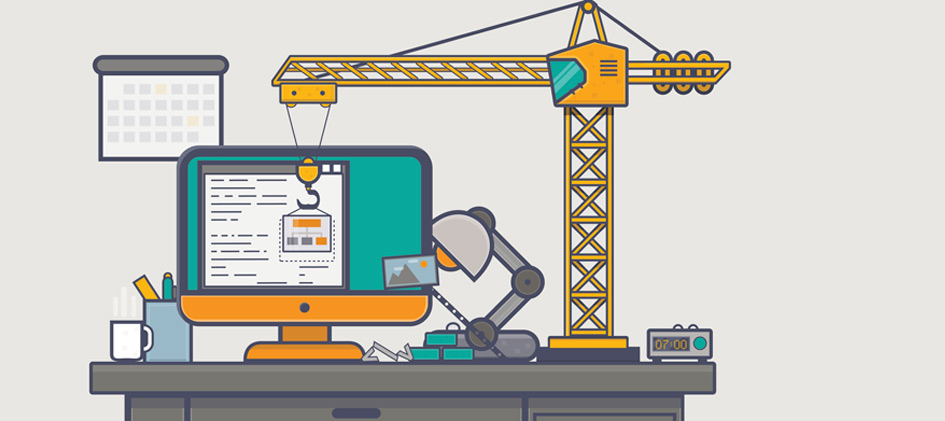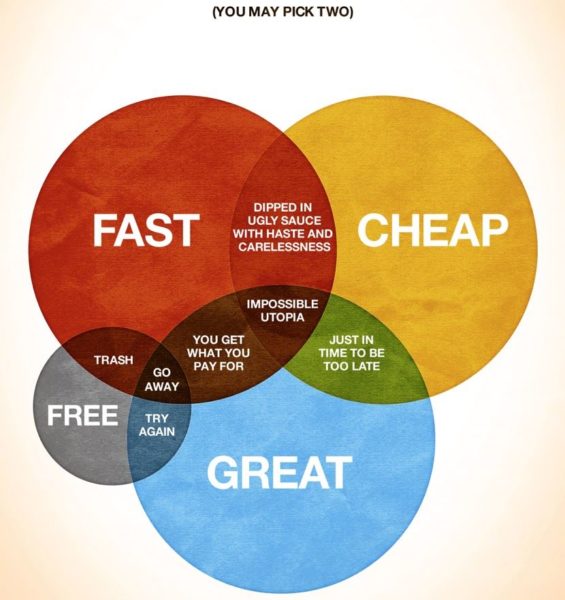
So you’ve decided it’s time for an upgrade to your website! That’s a good idea since technology moves fast and there are some cool new features you’d like to integrate into your existing site. Besides, that stunning design you put on your website several years ago is now stunning for all the wrong reasons.
But how long can you expect it to take before your professional, custom-built website is ready to launch? Like, are we talking weeks? Months? …. Years?
You’ve come to the right place for getting a better idea of what is involved. Keep reading to get the scoop on the ins and outs of what goes into a professionally built website so that your expectations are properly aligned as you heading into this exciting new project.
What does a great website look like?
First things first: what is our target here anyway? How do we know that we’ve built a website that truly adds value to your business?
Your website needs to fulfil its purpose – not just look pretty. It’s easy to get a nice-looking template and throw some content at the page, but a successful website is one that understands and supports the user, from the moment they enter the page until they become a customer.
Defining this user journey is made possible by thorough discovery, wireframing, design and more – making sure that each component is working together towards the common goal of delivering on your user’s expectations.
What’s involved in building a Custom Website that delivers results?
The Discovery Process
It isn’t hard to build a website that doesn’t understand the target audience. It also isn’t hard to generate boring content and throw together a user interface that is confusing and slow.
But that, presumably, is not what you are trying to do.
The reason exceptional websites look beautiful, deliver answers to your questions and seem to anticipate your every need is that they are the result of an in-depth discovery process. The design agency goes through an intensive process when considering the client.
During the Discovery process, we’re going to flesh out and understand the true goals and expectations for this website. Who is the audience and what are they looking for? What challenges do they have that will be answered by this website and product?
Beginning to build a website without first understanding who it is for is like setting off to an unknown destination without a map. You’re certainly going to get somewhere – but it’s unlikely to be where you had planned on going.
Expected Timeline for Discovery: It will likely take at least 2-4 weeks, which includes a few meetings between the website developer and the client, to fully grasp the purposes and goals of the new website, the nuances of the industry and the target audience.
What are your priorities?
There’s a familiar concept in the world of professional web design:
“Cheap, fast and good. Pick two.”
If you are looking for a visually-stunning website delivered relatively quickly, it’s not going to be cheap.
If you want an exceptional website but need to stick to a tight budget, you can expect to wait for a while, since your project will naturally fall to the bottom of the priority list. You might need to expect a website that doesn’t load so either, as optimizing the performance of a website also takes time.
If you are looking for a fast and cheap solution, your website isn’t likely to be a masterpiece of content, design and excellent user experience.

Credit: https://matt.berther.io/
By understanding the constraints that your website development company is working within, you can better align your expectations with reality so that everyone stays on the same page.
Wireframing
Wireframing is the process of creating the blueprint for the website. Like an architect carefully crafting a solid foundation, we arrange the visual hierarchy so that information is presented in a visually pleasing and logical manner.
Imagine beginning to build a house and then hearing that the rooms would be better if they were arranged differently? Yeah, cutting corners on wireframing is a lot like that.
Building a website isn’t a matter of simply hurling images and content blocks at a blank page and keeping whatever sticks. By working with wireframes and getting approval on the look and feel of the content hierarchy, we prevent any time-wasting down the road. The result is a consistent and coherent experience for the users!
Expected Timeline for Wireframing: It’s fair to assume one week for the designers to really develop intelligent and user-friendly wireframes for each different type of page that will be on your website.
Design
There are a lot of websites out there that are remarkable. Some of them are remarkable for good reasons; others for bad reasons.
Design does a couple of important jobs:
For one, it sets an impression. First impressions aren’t so easy to shake. If you hear about an impressive, modern company, but their website design features the most innovative design trends of 1997, you’re less likely to trust that company.
Second, design influences the user experience. The way users experience and “flow” around the website is based on the intelligent layout of content, buttons, media and other features.
In short, design informs the entire functionality of the website. That’s a pretty important task.
In stark contrast, poor design is a hindrance. It sets up confusing roadblocks instead of clear road signs. It creates headaches.
Excellent design is the result of more than just a sudden burst of creative inspiration. Giving some time to the process of creating and developing design concepts (not to mention letting them steep a little for flavour) will result in something that creates an emotional connection with the audience and stands out for all the right reasons.
Expected Timeline for Design: Book about 1-4 weeks into the calendar for design, depending on the size of the website. Once again, this includes some back-and-forth with the client to allow for adjustments as needed.
Writing the Code
After the design is locked down, it’s time to turn all that planning into a real product.
It’s important to make sure that the company writing your website’s code is working up to industry standards. Otherwise, you’ll find out later as your visitors flee the website because of poor security and clumsy load speeds.
Imagine you bought a fancy Ferrari but found out soon after that the engine inside was junk? That’s the experience of a website that looks great, but with poorly implemented functionality.
An added point of interest on this topic is that modern websites need to be built to be responsive. This means that they intelligent rearrange themselves to match the device you are viewing them on, from desktop computer to mobile phone. Building this kind of flexibility into the website takes a bit of time and planning.
Expected Timeline for Developing: Depending on the complexity of the website, you can expect at least 4-8 weeks of work, or even more, for the developers to build the design out into a finished website.
Writing Content that is Worth Reading
It isn’t hard to pull together some content for a website. There, I said it.
What does take a little more time and effort is to write content that is worth reading – that interests the reader, then prompts them to explore the website further and make a purchase.
So many websites have content that sound like it could have been spit out of a machine programmed to be as generic as possible:
“We are a team of experienced, industry-leading professionals who are excited to add value to your company with our tested and proven product. We work hard to exceed your expectations with a unique and personal approach to business!”
This kind of content might mean you get to cross off another item on your website development checklist, but it isn’t likely to get anything out of your readers – except maybe a stiff yawn.
Besides, search engines are going to decide how valuable your website is based on its content. Cut corners on content and you can make enemies out of both your readers and the search engines.
Expected Timeline for Content: Count on at least a couple of hours per page of content, if you want something that your readers will actually enjoy.
Quality Assurance
The final step is Quality Assurance. This is important for ensuring that everything is stable and secure. The last thing we want is to rush a project to the finish line, only to realize that it doesn’t satisfy the requirements.
A professional website is the result of professional work from beginning to end. Skipping any of the steps mentioned above will put you at the risk of promoting a website that doesn’t meet the needs of your clients. You don’t want to be the proud owner of an inferior product – and we have no interest in making inferior products.
Expected Timeline for Quality Assurance: Quality Assurance happens at each step throughout the project, so the speed really depends on how promptly the client and developer communicate together.
What issues can cause a website development project to be delayed?
Skipping the Discovery Phase and Consequently Not Setting the Right Goals
You’ve always trusted your gut. And right now your gut is telling you that taking the time to research and understand your customer is a bunch of baloney.
After all, the fastest way to get a website finished is to start building it right away, right?
Rushing a website design will inevitably lead to one of two things:
- The project gets repeatedly delayed for adjustments
- The final product is underwhelming, to say the least.
Fail to plan; plan to fail.
Communication Response Time
You open your email. New message from your developers. The subject line says “Approval Required”. What do you do?

“Urgent, eh? That can probably wait for a month or two for a response…”
Reliable and consistent interaction between the designers, developers and you, the client, is vital. The more complicated that approval procedure is, the longer it will take to nail down details.
Building a website isn’t always a straightforward job. Even with the most rigorous and exhaustive planning, it can become evident during the project that design or structural adjustments are necessary.
Agencies that build professional websites will have methods of streamlining communication in-house. However, designers or developers will sometimes come knocking on your door to ask for insight into an important piece of the puzzle. Delaying that answer can stall the project – especially when more than one group is relying on that answer in order to move forward.
Delays in Content Development
Since creating excellent content takes long hours and hard work, it can be easy to overlook this step or give it the “we’ll do it later” status.
Designers can often forge ahead using the traditional Lorem Ipsum placeholder text, but design and content often go hand-in-hand. Without an accurate understanding of the quantity and style of content, the designers might need to take a few steps back when the delivered content doesn’t fit the layout.
To put it simply, a great website requires great content. By putting a priority on developing writing and media that adds value to your site – or by entrusting that task to professionals – you will keep your project from getting bogged down.
Summary
As you brainstorm your needs and goals for your new website, consider your priorities. Professional custom website design and development requires time and expertise. There’s no way around that.
We’re all familiar with the idea of “you get what you pay for”. In today’s marketplace, businesses are increasingly expected to deliver an exceptional online experience. In many situations, your website acts as your “handshake” with a potential client – it sets the impression for your company.
Carefully weigh your wants and your needs. If a poor online experience is holding your business back, a website might be the difference that pushes you up over the plateau.
If you set your standards low then I bet you could have your website running in a few days.
But if you’re asking for a boatload of features, custom design and kickass content then, yeah, it might take a few months.
And it will be totally worth it.
